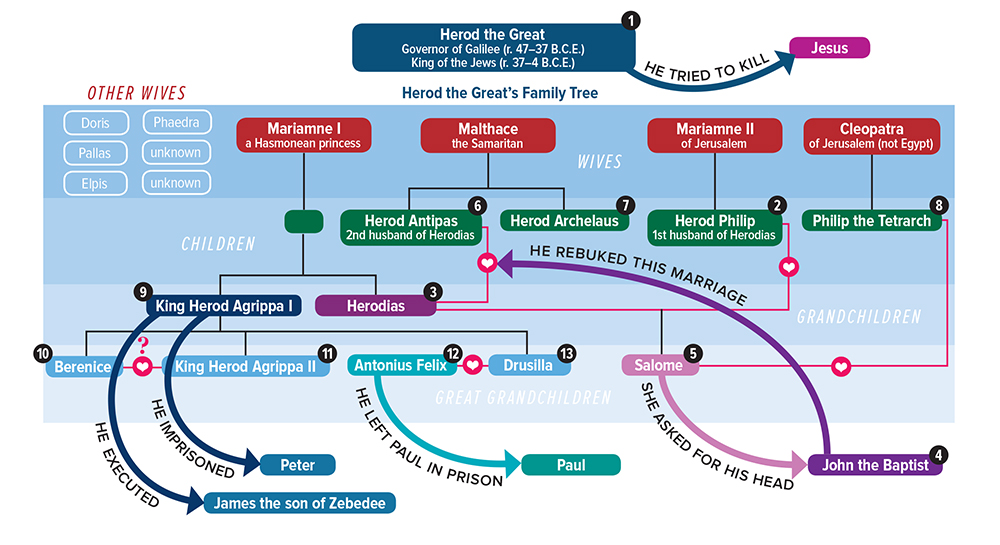In “New Testament Political Figures Confirmed” in the September/October 2017 issue of Biblical Archaeology Review, Purdue University scholar Lawrence Mykytiuk examines the political figures in the New Testament who can be identified in the archaeological record and by extra-Biblical writings. Below, see a visualization of the Herodian family tree and key events in the New Testament related to members of the Herodian family.—Ed.
BAS Library Members: Read Lawrence Mykytiuk’s article “New Testament Political Figures Confirmed” in the September/October 2017 issue of BAR.
Not a BAS Library or All-Access Member yet? Join today.

The Herodian family tree and key events in the New Testament related to members of the Herodian family. Click to enlarge. Credit: Biblical Archaeology Society.
Selected Members of the Herodian Family and Roman Governors Who Are Significant in New Testament Events
The family tree above includes only the Herodian family members in the New Testament plus most of the Roman governors it mentions. It is not a complete family tree. Boldface in the narrative statements below signifies the person is referred to in the New Testament.
Earlier Outcomes: Attempt to kill the infant Jesus, execution of John the Baptist, and the trial of Jesus
1. Herod the Great, founder of the dynasty, tried to kill the infant Jesus by the “slaughter of the innocents” at Bethlehem.
2. Herod Philip, uncle and first husband of Herodias, was not a ruler.
3. Herodias left Herod Philip to marry his half-brother Herod Antipas, Tetrarch of Galilee & Perea.
4. John the Baptist rebuked Antipas for marrying Herodias, his brother’s wife, while his brother was still alive—against the law of Moses.
5. Salome danced for Herod Antipas and, at Herodias’s direction, requested the beheading of John the Baptist. Later she married her great-uncle Philip the Tetrarch.
6. Herod Antipas, Tetrarch of Galilee &: Perea (r. 4 B.C.E.–39 C.E.), was Herodias’s uncle and second husband. After Salome’s dance and his rash promise, he executed John the Baptist. Much later he held part of Jesus’ trial.
Become a Member of Biblical Archaeology Society Now and Get More Than Half Off the Regular Price of the All-Access Pass!
Explore the world’s most intriguing Biblical scholarship
Dig into more than 9,000 articles in the Biblical Archaeology Society’s vast library plus much more with an All-Access pass.

7. Herod Archelaus, Ethnarch of Judea, Samaria and Idumea (r. 4 B.C.E.–6 C.E.), was replaced by a series of Roman governors, including Pontius Pilate (r. 26–36 C.E.).
8. Philip the Tetrarch of northern territories (r. 4 B.C.E.–34 C.E.) later married Herodias’s daughter Salome, his grandniece.
Later Outcomes: Execution of James the son of Zebedee, imprisonment of Peter to execute him, and the trial of Paul
9. King Herod Agrippa I (r. 37–44 C.E.) executed James the son of Zebedee and imprisoned Peter before his miraculous escape.
10. Berenice, twice widowed, left her third husband to be with brother Agrippa II (rumored lover) and was with him at Festus’s trial of Paul.
11. King Herod Agrippa II (r. 50–c. 93 C.E.) was appointed by Festus to hear Paul’s defense.
12. Antonius Felix, Roman procurator of Judea (r. 52–c. 59 C.E.), Paul’s first judge, left him in prison for two years until new procurator Porcius Festus (r. c. 60–62 C.E.) became the second judge, and Paul appealed to Caesar.
13. Drusilla left her first husband to marry Roman governor Felix.
Our free eBook Ten Top Biblical Archaeology Discoveries brings together the exciting worlds of archaeology and the Bible! Learn the fascinating insights gained from artifacts and ruins, like the Pool of Siloam in Jerusalem, where the Gospel of John says Jesus miraculously restored the sight of the blind man, and the Tel Dan inscription—the first historical evidence of King David outside the Bible.
Related reading in Bible History Daily:
30 People in the New Testament Confirmed by Lawrence Mykytiuk
Did Jesus Exist? Searching for Evidence Beyond the Bible by Lawrence Mykytiuk
53 People in the Bible Confirmed Archaeologically by Lawrence Mykytiuk
Herod the Great: Friend of the Romans and Parthians? by Jason M. Schlude
Machaerus: Beyond the Beheading of John the Baptist
Herod Antipas in the Bible and Beyond
Paul’s First Missionary Journey through Perga and Pisidian Antioch
This Bible History Daily feature was originally published on September 25, 2017.
Get more biblical Archaeology: Become a Member
The world of the Bible is knowable. We can learn about the society where the ancient Israelites, and later Jesus and the Apostles, lived through the modern discoveries that provide us clues.
Biblical Archaeology Review is the guide on that fascinating journey. Here is your ticket to join us as we discover more and more about the biblical world and its people.
Each issue of Biblical Archaeology Review features lavishly illustrated and easy-to-understand articles such as:
• Fascinating finds from the Hebrew Bible and New Testament periods
• The latest scholarship by the world's greatest archaeologists and distinguished scholars
• Stunning color photographs, informative maps, and diagrams
• BAR's unique departments
• Reviews of the latest books on biblical archaeology
The BAS Digital Library includes:
• 45+ years of Biblical Archaeology Review
• 20+ years of Bible Review online, providing critical interpretations of biblical texts
• 8 years of Archaeology Odyssey online, exploring the ancient roots of the Western world in a scholarly and entertaining way,
• The New Encyclopedia of Archaeological Excavations in the Holy Land
• Video lectures from world-renowned experts.
• Access to 50+ curated Special Collections,
• Four highly acclaimed books, published in conjunction with the Smithsonian Institution: Aspects of Monotheism, Feminist Approaches to the Bible, The Rise of Ancient Israel and The Search for Jesus.
The All-Access membership pass is the way to get to know the Bible through biblical archaeology.
The post Herod the Great and the Herodian Family Tree appeared first on Biblical Archaeology Society.

0 Commentaires